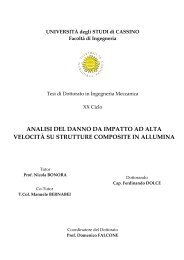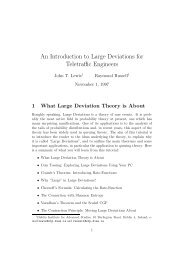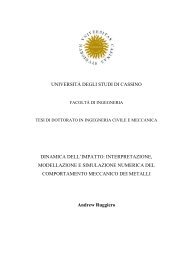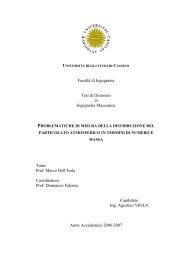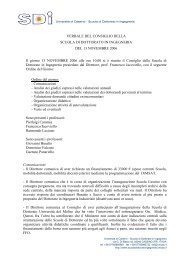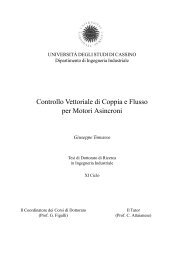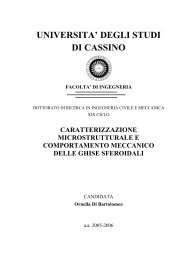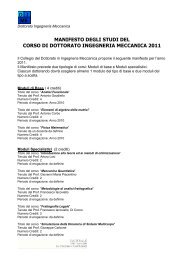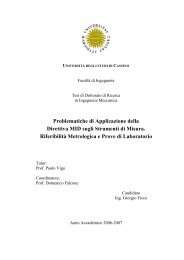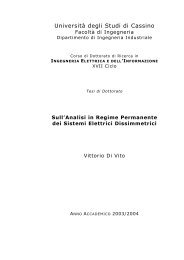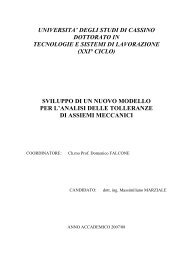Finite Strain Shape Memory Alloys Modeling - Scuola di Dottorato in ...
Finite Strain Shape Memory Alloys Modeling - Scuola di Dottorato in ...
Finite Strain Shape Memory Alloys Modeling - Scuola di Dottorato in ...
You also want an ePaper? Increase the reach of your titles
YUMPU automatically turns print PDFs into web optimized ePapers that Google loves.
In Fig. 8.6 the applied force is plotted versus the <strong>di</strong>splacement of the po<strong>in</strong>t A alongthe free edge for the small and f<strong>in</strong>ite stra<strong>in</strong>s models.In the first case, i.e. T > A , the arch is subjected to an <strong>in</strong>creas<strong>in</strong>g value of the forcefuntil a maximum of 180N , ma<strong>in</strong>ta<strong>in</strong><strong>in</strong>g constant the temperature at 285K ; then theload is removed allow<strong>in</strong>g the element to recover the start<strong>in</strong>g con<strong>di</strong>tions. Fig. 8.5shows the undeformed and the deformed configurations of the analyzed structure.Therefore, if the material is loaded at a temperature aboveAfmacroscopic nonl<strong>in</strong>earlarge deformations occur and they are totally recovered dur<strong>in</strong>g unloa<strong>di</strong>ng,s<strong>in</strong>ce the product phase, i.e. the s<strong>in</strong>gle-variant martensite, is not stable at this value oftemperature. An hysteretic loop <strong>in</strong> terms of stress and stra<strong>in</strong> (pseudolelasticity) isdescribed.In the second case, i.e. Ms< T < As, the arch is subjected to an <strong>in</strong>creas<strong>in</strong>g value ofthe force until a maximum of 120N , ma<strong>in</strong>ta<strong>in</strong><strong>in</strong>g constant the temperature at 240K .F<strong>in</strong>ally, <strong>in</strong> the third case, i.e.T≤ Mf, the maximum value of the axial force is 90Nand the temperature is ma<strong>in</strong>ta<strong>in</strong>ed constant at 223K .For the cases <strong>in</strong> which T < A = 248Kalso the stra<strong>in</strong> recovery <strong>in</strong>duced by a heat<strong>in</strong>gscycle is <strong>in</strong><strong>di</strong>cated. In fact, after the loa<strong>di</strong>ng-unloa<strong>di</strong>ng cycle, a residual stra<strong>in</strong>rema<strong>in</strong>s. With a thermal cycle <strong>in</strong> which the temperature reaches the maximum valueof 400K and then reduces to the start<strong>in</strong>g value of temperature, the shape memoryalloy is able to recover the orig<strong>in</strong>al configuration go<strong>in</strong>g back to the po<strong>in</strong>t def<strong>in</strong>ed byzero stress and stra<strong>in</strong> level.All the results underl<strong>in</strong>e the model capability to pre<strong>di</strong>ct:♦ the superelastic effect;♦ the shape-memory effect.140



